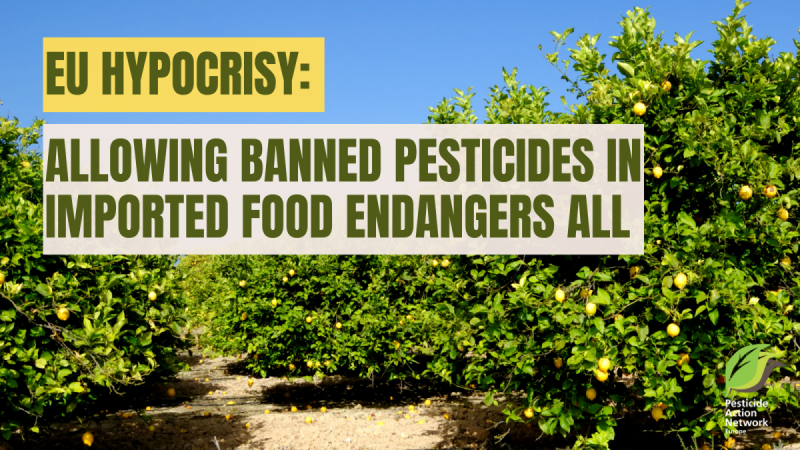In a deeply concerning move, the European Commission plans to allow residues of three highly toxic pesticides in certain imported food. The substances are banned in the EU due to their severe health risk. It would endanger farmers and workers in third countries and create unfair competition for EU farmers. The decision would also put European consumers at risk since the residues end up on their plates. The proposal was already adopted by the EU Member States in April, now newly re-elected Members of the European Parliament propose a veto.
Carbendazim, thiophanate-methyl, and cyproconazole are not just ordinary pesticides; they are highly toxic. Classified as mutagenic, toxic to reproduction or endocrine disruptors, as well as highly toxic to aquatic life, these pesticides can cause diverse harmful effects. The EU rightly banned them to protect public health and the environment. No residues should be allowed in EU food.
Despite these risks, the Commission plans to allow residues in certain imported food products, arguing that they comply with international standards and are necessary for trade purposes. In some particular cases, the proposed maximum residue levels (MRL)s are high. For limes, for example, the Commission is setting an MRL of 6mg/kg of the endocrine-disrupting thiophanate-methyl per product. For the mutagenic and toxic to reproduction carbendazim, okra/lady fingers is set at 1.5 mg/kg. These values are 600 and 150 times more than the default limit of 0.01 mg/kg set by law when a substance is banned in the EU.
Beyond the risk for European consumers, this creates a clear double standard. EU farmers, bound by the pesticide regulation, rightfully can no longer use these dangerous pesticides because they do not meet the EU safety criteria. This places them at a competitive disadvantage, in contradiction to the promise to better protect and support EU farmers.
The most serious implications however, will take place outside Europe. By allowing these residues, the EU is tacitly endorsing the continued use of these toxic pesticides abroad. Workers are exposed to significant health risks, and local communities and the environment are contaminated. This is a betrayal of the EU’s commitment to global human rights and environmental protection.
MEPs plan to veto the proposal
Fortunately, a coalition of MEPs from Renew, S&D, the Greens and the Left is pushing back with a proposal to veto this decision. The proposal will be discussed and submitted to vote in the Environment (ENVI) committee on 12 September and then on 14 September in plenary, if it is adopted in ENVI. PAN Europe urges MEPs to support this objection.
Earlier this year, the European Parliament already adopted a similar objection to a regulation that sought to allow residues of thiacloprid in certain important products—a pesticide with similar toxic properties. This forced the Commission to lower the MRLs of thiacloprid.
Background
- Carbendazim has been banned in the EU since November 2014 due to its classification as a mutagenic substance (category 1B) and toxic for reproduction (category 1B), meaning it can cause genetic defects and damage fertility/the unborn child. It’s also highly toxic to aquatic life, posing serious risks to ecosystems.
- Thiophanate-methyl, banned in October 2020, is similarly hazardous. It metabolizes into carbendazim and carries classifications as a suspected mutagen and a suspected carcinogen (category 2). Moreover, it is an endocrine disruptor, potentially leading to long-term health effects and is especially dangerous for young children and pregnant women.
- Cyproconazole, which was banned in May 2021, is known to be toxic for reproduction (category 1B) and is also harmful to aquatic environments.
Read more
